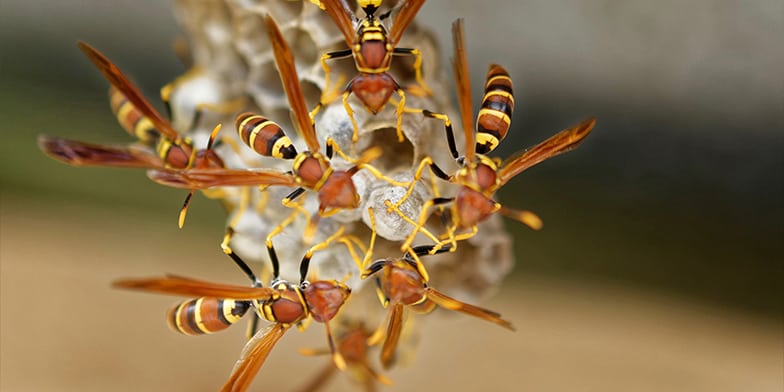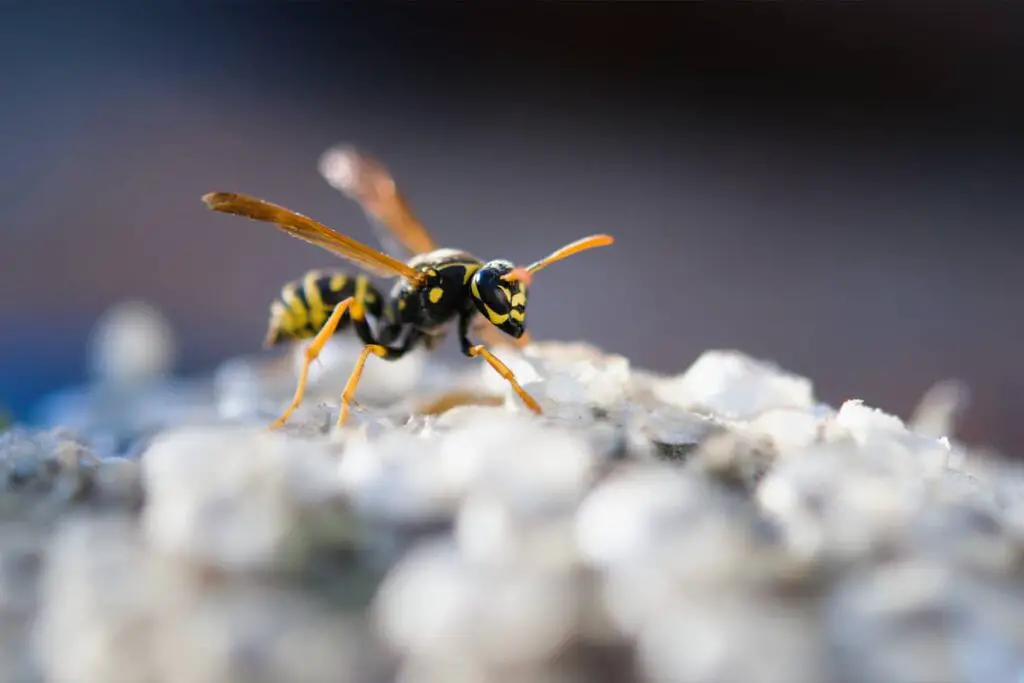
When we aren’t cowering in fear of wasps every time we hear that unforgettable buzzing sound, we like to watch them; studying their behavior to better understand how they plan to take over the world. It certainly doesn’t help that the way they are classified includes “Vulgaris,” and, “Apocrita.” One particular peculiarity wasps have is flicking their wings. What could possibly be the purpose?
It is not fully understood why wasps will flick their wings, leaving professional and amateur entomologists to only speculate until more is known. However, the most likely reason appears to be in order to attract the attention of potential threats to warn them to stay away from either an individual wasp or the hive.
There are several different theories about why wasps flick their wings. If you’re curious about this behavior, you can explore these theories below to learn more.
What is the Flicking Wasps do With Their Wings?
If you’re brave enough to get close to a wasp that is spending a significant amount of time resting on a single spot, you might see it “flicking” its wings. Specifically, you would see a wasp’s wings flapping but instead of the entire wing flapping up and down or side to side as you might expect, they act more like noodles.
As the bottom half of the wings spread out, the tops are catching up, and by the time the bottom half of the wings are brought back together, the tops are still flicked out. It’s kind of like when you swing out your arm and flick your hand.
This is pretty bizarre to most of us since we expect the whole wing to move together in the standard motion we attribute to flapping. The big question is why do wasps do this? And do they all do this or is it only a few species?
Flicking Wings to Attract Mates
The first theory we’ll explore is the idea that wasps are trying to attract mates. For those who don’t know, all of the wasps you see around food or trying to attack you are all female.
During the end of summer or in the fall, female virgin queens and male drone wasps from a different colony will mate. For solitary wasps, they mate during the spring, but in either case in order to mate, they have to be able to find each other.
This first theory comes from an experiment conducted by four entomologists in 2010 about acoustic communication wasps make between each other. They noticed that the females of a particular parasitoid wasp Glyptapanteles flavicoxis attract the males through a specific sound of their wings, combined with pheromones.
While the sound from the females came from when they fan their wings, which is a motion we are more familiar with, the entomologists also discovered that specific wing beats from the males will cause the females to create auditory and visual responses. So, flicking may be one of those signals.

Flicking to Regulate Body Temperature
Another theory wasps flick their wings is to cool themselves down during hot days. The control of their body’s internal temperature is called thermoregulation. Wasps have very limited means of performing thermoregulation, and because of this, they can easily die if their bodies reach 113 degrees Fahrenheit (44.9 degrees Celsius) or 34 degrees F (1 degree C).
The queens have no problem surviving winters that reach 5 degrees F (or -15 degrees C) but enough heat will certainly kill wasps because they are classified as cold-blooded insects.
Cold-blooded or ectothermic creatures have an internal body heat that is the same as the temperature of their surrounding environment because they have limited means of warming and cooling themselves. In addition to using the common means of the sun and shade, one of the few ways wasps can cool down or warm up is to use their flight muscles.
This is not a common means of thermoregulation, however, because the wasp consumes too much of its energy for the effort to be worth it. According to t Martin from PestABC, the thorax will warm up before any other part of the body, even before the wasp flaps its wings. This is because wasps have a high metabolism that keeps them warmer even while resting.
As the wasp flicks its wings, it may be working to redistribute the fluid inside its body to the head area where the fluids are evaporated. This is called “artificial sweating,” since fluids are evaporating without the use of sweat glands.
Flicking to Attract Attention
This theory is particular to spider wasps, especially the Tarantula Hawk. Justin Schmidt, author of The Sting of the Wild: The Story of the Man Who Got Stung for Science points out that Tarantula Hawks will move along the ground and flick their wings in order to be noticed.
You might be wondering why on earth a predatory insect would want to be noticed, but Schmidt believes it ties into the Tarantula Hawk’s coloring. These spider wasps often have glistening iridescent bluish-black or black bodies with bright orange wings. These colors let their potential predators know that they are dangerous.
If a threat starts getting too close, the tarantula hawk will start flicking its wings and move to make sure the threat does see it, just like when a rattlesnake shakes its rattle when you’re getting too close. As the Tarantula Hawk flicks its wings, it will also create a strong buzzing noise with their wings, followed by a pungent odor as a last warning.
Now, spider wasps are a solitary species, meaning they don’t have nests. If flicking is used for self-defense as a warning to larger threats and predators, do social wasps use it too? Common wasps, which have nests, have been seen doing this, but individual common wasps may not be doing it for their own protection.
Alerting the Colony Through Flicks
The final theory is that a guard wasp is alerting their colony of approaching danger. This is another very likely reason for this flicking, since it’s so closely related to the self-defense theory, which we’ve established at least one wasp does.
In 1981 a scientist by the name of Jeanne came to the conclusion that wasps will pump their abdomens in order to spray their venom into the air around them as a means of warning their colony that danger is approaching.
Typically, when a threat gets too close to the hive, one wasp will begin flying around the threat and spraying the alarm pheromone that will alert all nearby wasps of the threat. These nearby worker wasps will then arrive as reinforcements to attack the threat.
A video taken by lensref shows a common wasp flicking her wings. At first, it looks like she’s alone on a metal structure until you see another wasp emerging from a hole on the side of it.
This suggests the first wasp is warning the cameraman while sending a buzzing signal to the rest of the colony. It could very well be the second wasp that was called by that signal to help check out that potential threat.
Conclusion
In conclusion, the behavior of wasps is still in the process of being uncovered and better understood by entomologists, even as we speak.
For now, the absolute reason why wasps flick their wings, whether all wasp species flick their wings, and which wasp species do, are either the private knowledge of certain scientists until they can publicly share what they know, or it’s yet to be discovered by said scientists.
Resources:
- Wasp flapping its wings in the heat – YouTube
- Wasps and Their Ways: Chapter 11 (kellscraft.com)
- Evidence for acoustic communication in the parasitoid wasp Glyptapanteles flavicoxis – Danci – 2010 – Entomologia Experimentalis et Applicata – Wiley Online Library
- Nest thermoregulation of the paper wasp Polistes dominula – ScienceDirect
- Spider Wasp | NC State Extension (ncsu.edu)
- Evidence for acoustic communication in the parasitoid wasp Glyptapanteles flavicoxis – Danci – 2010 – Entomologia Experimentalis et Applicata – Wiley Online Library
- Paper Wasp (tamu.edu)
- Entomologists to Contact | Department of Entomology (unl.edu)
- Life Cycle of the Wasp (wasp-removal.com)
- How Do Wasps Reproduce? | Animals.mom.com
- The Sting of the Tarantula Hawk: Instantaneous, Excruciating Pain (undark.org)
Driven by a passion for those tiny creatures that rule our world, we at Bug Domain strive to be your go-to resource for information on insects.




